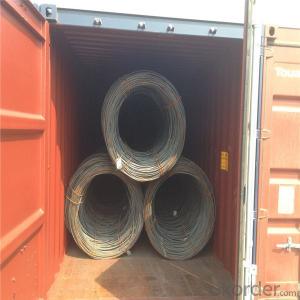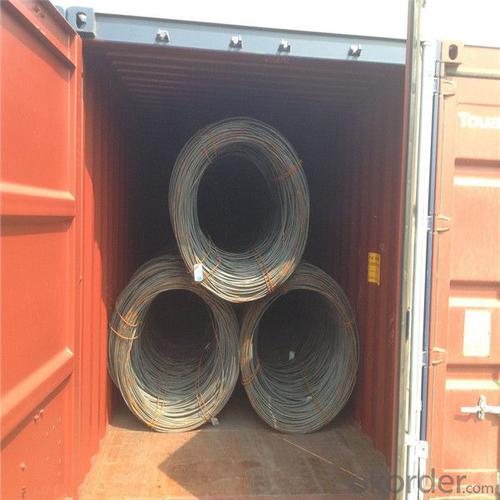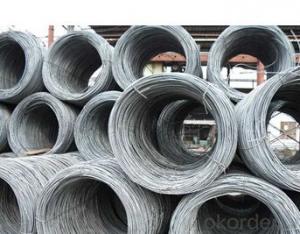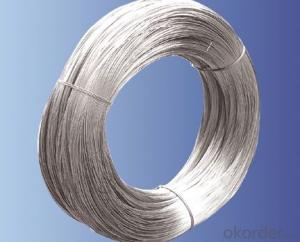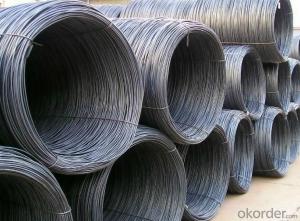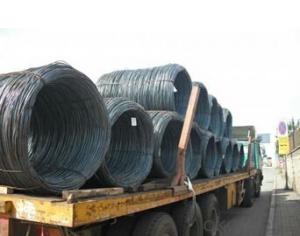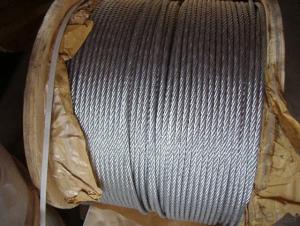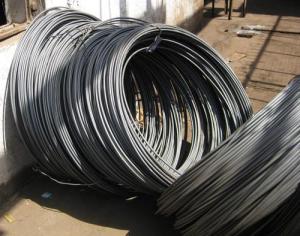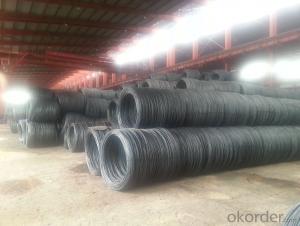Steel wire rod high quality Standard AISI, ASTM, BS, GB
- Loading Port:
- Tianjin
- Payment Terms:
- TT OR LC
- Min Order Qty:
- 50 m.t.
- Supply Capability:
- 15234 m.t./month
OKorder Service Pledge
OKorder Financial Service
You Might Also Like
Specification
Wire rod is a rolled alloy or nonalloy steel product, produced from a semi (e.g. bloom) and having a round,
rectangular or other cross-section. Particularly fine cross-sections may be achieved by subsequent cold
forming (drawing). Wire rod is wound into coils and transported in this form. .
Our Advantage: High quality steel products from 1 class mills in
Reasonable price
Professionalism of the products
On-time delivery
Complete documents and certificates
Sincere service to meet our clients' requirements
Product Description :
Standard | AISI, ASTM, BS, DIN, GB, JIS |
Material/steel grade | Q195-Q235,SAE1006B,SAE1006CR, SAE1008B, SAE1008CR, SAE1010B, SAE1018B, or according to customers requirements |
Wire Gauge | 5.5-12mm |
Coil weight | 1.8-2.1mts |
MOQ | 25MT |
Delivery Time | 15-30 days after receipt of L/C or deposit by T/T |
Packing | In coil and load in container, if large quantity, by bulk vessel; Can be packed as customers' special requirements |
Payment terms | 1).100% irrevocable L/C at sight. 2).30% T/T prepaid and the balance against the copy of B/L. 3).30% T/T prepaid and the balance against L/C |
Application | widely used in machinery parts, manufacturing industry, electronics industry, metal tools and others |
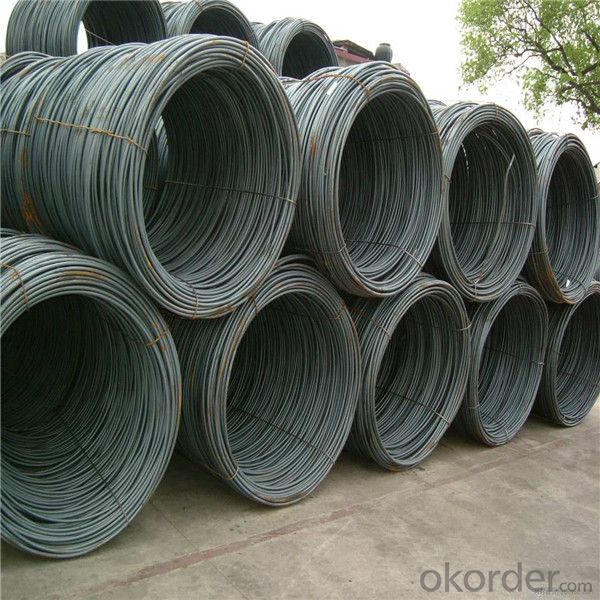

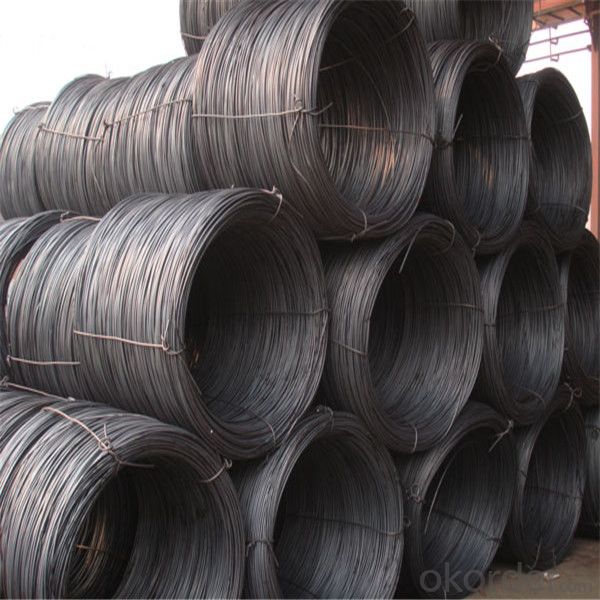
Application :
It generally used in braiding the hose for bathing product and machinery. With it
good flexibility, resistant to high temperature and resistant to corrosion, it
used widely in many industries.
Packing :
Hot-rolled wire rod is held in a unit with at least four steel straps in the
transverse direction and transported and stored without further packaging.
Before
the steel strapping is applied, the wire rod must be sufficiently compressed.
The strapping is fixed in the transverse direction with a single circumferential
strap so that the strapping does not slip and cause the coil to come apart.
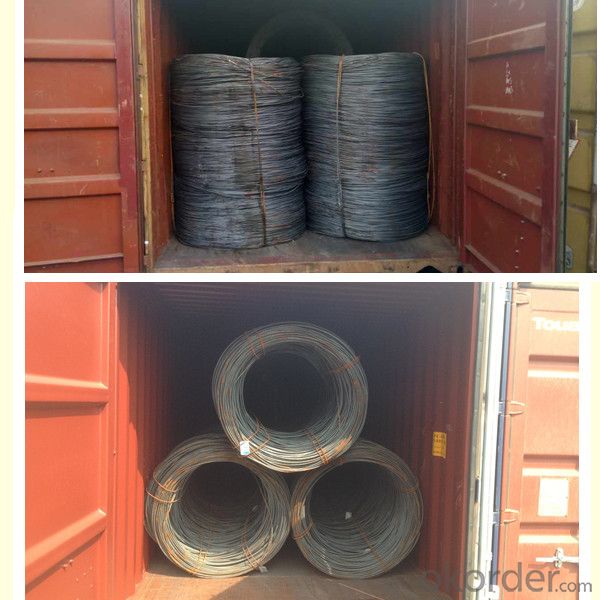
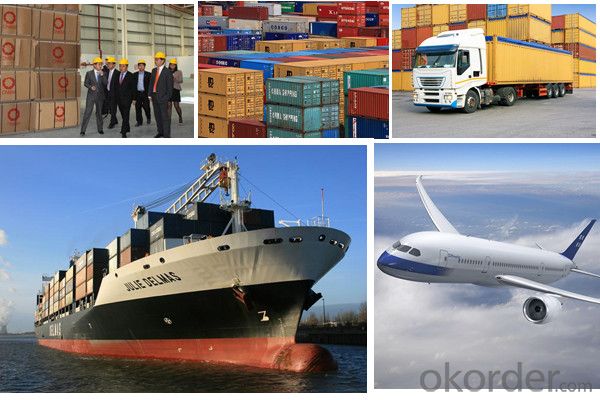
Our service:
(1) We cooperate with famous factories with advanced equipment and well trained workers.
(2) We can provide factory price with trading company service.
(3) We continuously work on the improvement of our processes, guaranteeing
consistently high standards of quality to keep none compensation.
(4) We guarantee 24 hours response and 48 hours solution providing service.
(5) We accept small order quantity before formal cooperation.
(6) We deliver the agreed quality at the agreed time, reacting to changes in
customer wishes in a flexible way.
(7) Due to our volume and selling power, we have excellent freight rates with
shipping lines.
(8) We strive to always be fair and honest in our dealings with customers.
(9) We strive to work together with customers to achieve much more than we can
achieve alone.
(10) Through our passion and commitment we aim to be a market leader in all our
key markets. To maintain our position as market leader we must continue to add
value in all that we do.
FAQ:
1.Q: What's your MOQ(minimum order quantity)?
A: One full container, mixed acceptable .
2. Q: What's your packing methods?
A: Packed in bundle or bulk ..
3. Q: How can I buy CNBM products in my country?
A:Please send us an inquiry or email ,we will reply to you if there is distributor in your country
4. Q: Can we visit your factory?
A: Warmly welcome. Once we have your schedule, we will arrange the
professional sales team to follow up your case.
5. Q: How long does it take to get the product if i place an order?
A:With the process of your requirements,we will pack and deliver in 3
-7 days. If it is by sea shipment,it will take 15-45 days depending on different locations
- Q: How is steel wire rod used in the manufacturing of wire for elevator counterweights?
- Steel wire rod is an essential component in the manufacturing of wire for elevator counterweights. The process begins with high-quality steel wire rods, which are typically made from carbon or alloy steel. These rods are subjected to a series of manufacturing processes to transform them into wire that meets the specific requirements for elevator counterweights. Firstly, the steel wire rods are cleaned and descaled to remove any impurities or surface contaminants. This ensures that the wire produced is of the highest quality and has excellent corrosion resistance. Next, the rods go through the process of drawing, where they are pulled through a series of dies to reduce their diameter and increase their length. This process imparts the desired tensile strength and flexibility to the wire. After the drawing process, the wire is usually annealed to relieve any internal stresses and enhance its ductility. This involves heating the wire to a specific temperature and then slowly cooling it. Annealing not only improves the mechanical properties of the wire but also enhances its resistance to fatigue and wear. Once the wire has been drawn and annealed, it undergoes surface treatment processes such as coating or galvanizing. Coating the wire with a protective layer, such as zinc or epoxy, helps to prevent corrosion and extend its lifespan. Galvanizing involves dipping the wire into a bath of molten zinc to create a protective zinc coating, which provides excellent corrosion resistance. Finally, the coated or galvanized wire is further processed to achieve the desired shape and size for elevator counterweights. It can be cut into specific lengths or wound onto spools for easier handling during the manufacturing process. The wire is then used to form the internal structure of elevator counterweights, which are crucial for balancing the elevator car and ensuring its smooth operation. In summary, steel wire rods play a vital role in the manufacturing of wire for elevator counterweights. They are subjected to various processes, including cleaning, drawing, annealing, and surface treatment, to produce high-quality wire with the necessary strength, flexibility, and corrosion resistance. This wire is then used to construct the internal structure of elevator counterweights, ensuring the safe and efficient operation of elevators.
- Q: What are the different types of wire drawing dies used for steel wire rod?
- There are typically two types of wire drawing dies used for steel wire rods: tungsten carbide dies and diamond dies. Tungsten carbide dies are commonly used for drawing steel wire rods with larger diameters, while diamond dies are used for finer wire diameters. These dies help in shaping and reducing the diameter of the wire rods during the drawing process, resulting in a smoother surface finish and improved mechanical properties.
- Q: How does the fatigue strength of steel wire rod vary with different wire drawing processes?
- The specific wire drawing process utilized can lead to varying fatigue strengths in steel wire rods. Wire drawing, a metalworking procedure that involves pulling a metal wire through a die to decrease its diameter and increase its length, is the key process. There are multiple wire drawing processes available, including wet drawing, dry drawing, and intermediate drawing, each having distinct characteristics and impacts on the fatigue strength of the steel wire rod. One factor that affects fatigue strength is the lubrication employed during the wire drawing process. Wet drawing entails immersing the wire rod in a lubricant to decrease friction and heat generation. This lubrication aids in minimizing surface defects and improving the fatigue strength of the wire rod. Conversely, dry drawing does not entail any lubrication, which can result in increased friction and heat generation, potentially leading to a decrease in fatigue strength. The reduction ratio, the ratio of the initial wire diameter to the final wire diameter, also plays a vital role. Higher reduction ratios can enhance the fatigue strength of the wire rod as the process aligns the grain structure and improves overall mechanical properties. However, excessively high reduction ratios can introduce internal defects or residual stresses, which can have a negative impact on fatigue strength. The subsequent heat treatment process after wire drawing can significantly influence fatigue strength as well. Heat treatment techniques, such as annealing or quenching, can enhance the microstructure of the wire rod and improve its fatigue strength. Annealing helps alleviate internal stresses and refine the grain structure, while quenching provides increased hardness and strength. These heat treatment processes can compensate for any potential reduction in fatigue strength caused by the wire drawing process. In conclusion, the fatigue strength of steel wire rod can vary depending on the wire drawing process employed. Factors such as lubrication, reduction ratio, and heat treatment techniques all have an impact on fatigue strength. It is crucial to carefully select the appropriate wire drawing process and associated parameters to optimize the fatigue strength of the steel wire rod for specific applications.
- Q: What are the alloying elements used in steel wire rod production?
- The alloying elements used in steel wire rod production can vary depending on the desired properties of the final product. However, some common alloying elements used in this process include carbon, manganese, silicon, and sometimes chromium, nickel, or molybdenum. Carbon is one of the most important alloying elements in steel wire rod production as it enhances the strength and hardness of the steel. The carbon content is typically kept within a specific range to achieve the desired mechanical properties. Manganese is another commonly used alloying element in steel wire rod production. It helps improve the strength and toughness of the steel and also enhances its hardenability during the heat treatment process. Silicon is often added to the steel to improve its resistance to oxidation and to enhance its electrical conductivity. It can also help control the grain size of the steel, which affects its mechanical properties. In some cases, chromium is added to steel wire rod to improve its corrosion resistance and to enhance its hardenability. Nickel is another alloying element that can be used to increase the strength and toughness of the steel, while molybdenum can improve its high-temperature strength and creep resistance. It is important to note that the specific alloying elements and their concentrations used in steel wire rod production can vary depending on the specific requirements of the final application. Steel manufacturers carefully select and adjust these alloying elements to achieve the desired mechanical, electrical, and chemical properties in the wire rod.
- Q: Can steel wire rod be used in high-temperature applications?
- Yes, steel wire rod can be used in high-temperature applications. Steel has excellent heat-resistant properties and can withstand high temperatures without losing its strength or structural integrity. However, the specific grade and composition of the steel wire rod should be considered to ensure it is suitable for the intended high-temperature environment.
- Q: How is steel wire rod tested for internal defects?
- Non-destructive testing (NDT) is commonly used to examine steel wire rod for internal defects. Various techniques are employed to detect and evaluate these flaws. Ultrasonic testing (UT) is a frequently utilized method that employs high-frequency sound waves to identify internal flaws. Ultrasonic waves are emitted by a transducer into the wire rod and any internal defects cause the waves to reflect back. The reflected waves are then analyzed to determine the defects' size, shape, and location. Another technique is eddy current testing (ECT), which utilizes electromagnetic induction to identify surface and near-surface defects. By passing an alternating current-carrying coil over the wire rod, any variations in electrical conductivity caused by flaws are detected. This method is particularly effective for detecting surface-related flaws like cracks. Magnetic particle testing (MPT) is also commonly employed. It involves magnetizing the wire rod and then applying iron particles to its surface. These particles accumulate around areas with internal defects, making them easily visible to inspectors. Furthermore, dye penetrant testing (DPT) can be utilized to detect surface-breaking defects. This method involves applying liquid dye to the rod's surface, which seeps into any cracks or openings. After a certain period, excess dye is removed and a developer is applied to make the defects visible. In conclusion, non-destructive testing techniques like ultrasonic testing, eddy current testing, magnetic particle testing, and dye penetrant testing allow for the identification and evaluation of internal and surface defects in steel wire rod without causing damage.
- Q: What are the common production processes for americium-coated steel wire rod?
- The common production processes for americium-coated steel wire rod typically involve a series of steps. Firstly, the steel wire rod is cleaned and prepared to remove any impurities. Then, a layer of americium is applied to the surface of the steel wire rod through techniques like physical vapor deposition or electroplating. After the coating process, the coated wire rod is inspected for quality control and tested for its desired properties. Finally, the americium-coated steel wire rod is packaged and ready for use in various applications such as nuclear fuel fabrication or scientific research.
- Q: What are the main factors influencing the choice of steel wire rod packaging materials?
- The main factors influencing the choice of steel wire rod packaging materials include the weight and dimensions of the wire rods, the required level of protection during transportation and storage, cost considerations, environmental impact, and regulatory requirements.
- Q: How is steel wire rod used in the production of wire mesh for animal enclosures?
- Steel wire rod is used as the primary raw material in the production of wire mesh for animal enclosures. It is first drawn through a series of dies to reduce its diameter and increase its length. This process helps to enhance the wire's strength and flexibility. The resulting thin and long steel wires are then woven or welded together to create a grid-like structure, forming the wire mesh. This sturdy and durable mesh is commonly used to construct animal enclosures as it provides a secure boundary, preventing animals from escaping while still allowing air circulation and visibility.
- Q: What are the different surface defects that can affect the thermal conductivity of steel wire rod?
- Some of the different surface defects that can affect the thermal conductivity of steel wire rod include scale formation, oxide layers, pitting corrosion, surface roughness, and any other irregularities or impurities on the surface of the rod. These defects can disrupt the flow of heat within the material, leading to decreased thermal conductivity.
Send your message to us
Steel wire rod high quality Standard AISI, ASTM, BS, GB
- Loading Port:
- Tianjin
- Payment Terms:
- TT OR LC
- Min Order Qty:
- 50 m.t.
- Supply Capability:
- 15234 m.t./month
OKorder Service Pledge
OKorder Financial Service
Similar products
Hot products
Hot Searches
Related keywords
